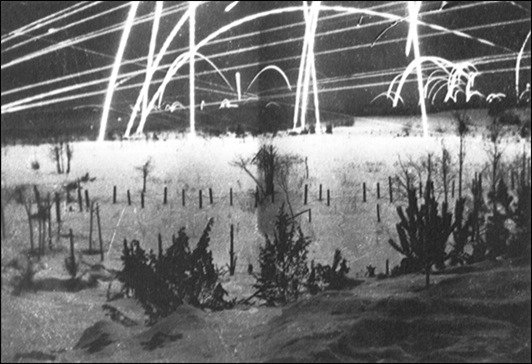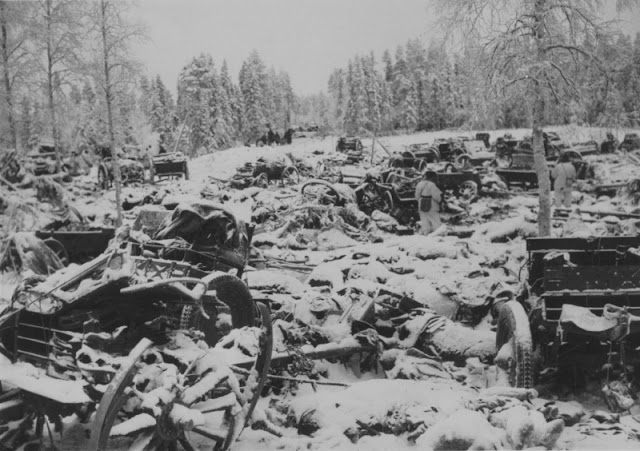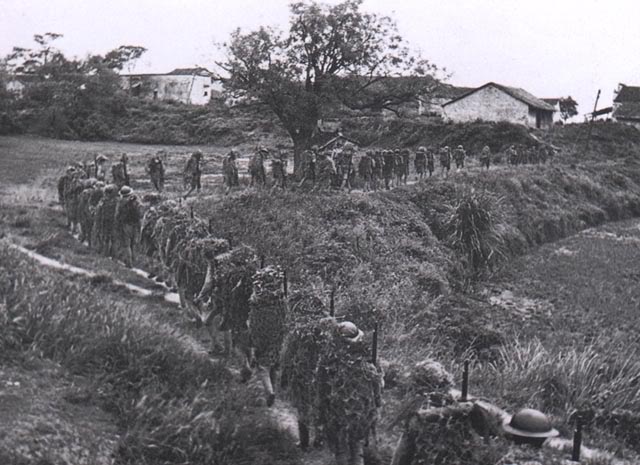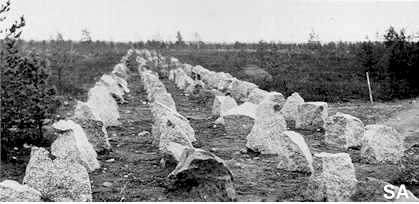Thursday 15 February 1940
 |
| A Finnish infantryman. |
The next, intermediate line is the "V-line" further back on the isthmus. It is not as well-prepared as the Mannerheim Line, but has some natural advantages. The question is whether the Finns still have enough men to hold it.
Even units still holding their forward positions in the Summa sector are down to fractions of the men they started with. The 274th Rifle Regiment, for instance, has lost 30-40% of its men. The brigade has resorted to reinforcing it with the unit's horse drivers who are not trained infantry. The Finnish 1st Brigade has lost about 60% of its men, with only 400 men remaining. Some units are wiped out completely, not all units are even able to report casualty figures. Of course, Soviet casualties are high as well - but there are endless streams of men and supplies backing the Soviet troops up, which is not the case for the Finns.
North of Lake Ladoga, the Finns are having better luck. The Finnish 9th Division destroy the motti at Lavajärvi village, taking 2 tanks, 5 field guns, 2 antitank guns, 8 trucks, 3 machineguns, 4 field kitchens, numerous rifles and ammunition. The Finns also surround what is left of the Soviets' "Dolin" Siberian ski brigade, which was sent as a relief force and now is minus its commander Dolin and down to 800 men.
Battle of the Atlantic: The German government states that, since First Lord of the Admiralty Winston Churchill has announced that all merchant ships in the North Sea will be armed, the U-boat fleet will treat all such ships as armed combatants. U-boats henceforth are directed to attack without warning any ship appearing to be under British control. In essence, this converts the entire sea around the British Isles into a zone of unrestricted underseas warfare.
U-50 (Kapitänleutnant Max-Hermann Bauer) torpedoes and sinks 4,895 ton Danish freighter Maryland at 02:07 far out in the north Atlantic. The entire crew of 34 perishes.
U-37 (Korvettenkapitän Werner Hartmann) torpedoes and sinks 1,206 ton Danish freighter Aase at 05:45 southwest of England. There is one survivor, and 15 perish.
U-26 ( Kapitänleutnant Heinz Scheringer) torpedoes and sinks 2,477 ton Norwegian freighter Steinstad at 08:37 about 75 miles west of Aran Island, Ireland. Thirteen perish, 11 crew survive.
U-48 (Kapitänleutnant Herbert Schultze) torpedoes and sinks 8,971 ton Dutch tanker Den Haag (Master C. Wijker) at 14:00 about 150 miles west of Ouessant, France. There are 13 survivors, while 26 perish. Schultze has been patient, as he sighted the tanker well before noon but had to wait for a Coastal Command flying boat to clear the area.
Convoy OB 92 departs from Liverpool, Convoy OA 92 departs from Southend, Convoy OG 18 forms at Gibraltar.
Anglo-Soviet Relations: Sir Stafford Cripps, a British Labour politician who is open about his Marxist leanings, visits Moscow.
German Military: Generalmajor Erwin Rommel, who coordinated Hitler's personal protection detail in Poland, is promoted to take command of the 7th Panzer Division. This is Rommel's choice, as he wished for an active divisional command, but not just any command. He already has turned down a mountain division of the sort in which he served (and gained national fame) during World War I. In essence, he calls in his favor with Hitler to get the panzer division that he wants.
British Military: General Wavell's position is recast as Commander-in-Chief Middle East.
US Government: President Roosevelt embarks on the heavy cruiser USS Tuscaloosa at Pensacola for a cruise to Panama and through the canal to the west coast of Central America. He will inspect the Panama Canal and discuss Pan-American defense with leaders along the trip.
 |
| The Dutch tanker Den Haag. |
February 1940
February 1, 1940: Second Battle of SummaFebruary 2, 1940: Soviet Assaults at Summa February 3, 1940: Soviets Capture a Bunker
February 4, 1940: Peace Talks in Stockholm
February 5, 1940: Allies to Invade Norway
February 6, 1940: Careless Talk Costs Lives
February 7, 1940: IRA Terrorists Executed
February 8, 1940: Spies!
February 9, 1940: The Welles Mission
February 10, 1940: Confiscation of Jewish Goods
February 11, 1940: Soviets Attack Mannerheim Line
February 12, 1940: Breaches In Mannerheim Line
February 13, 1940: Soviets Inching Forward in Finland
February 14, 1940: Soviets Batter Mannerheim Line
February 15, 1940: Finns Retreat
February 16, 1940: Altmark Incident
February 17, 1940: Manstein and Hitler Discuss Fall Gelb
February 18, 1940: Operation Nordmark
February 19, 1940: King Gustav Says No
February 20, 1940: Falkenhorst Commands Weserubung
February 21, 1940: Radar Advances
February 22, 1940: Friendly Fire
February 23, 1940: Soviets Present Their Demands
February 24, 1940: Fall Gelb Revised
February 25, 1940: Mr. Welles Comes to Visit
February 26, 1940: Battle of Honkaniemi
February 27, 1940: Finns Retreat Again
February 28, 1940: Overseas Volunteers Help Finland
February 29, 1940: Finns Accept Soviet Terms In Principle
2019


















